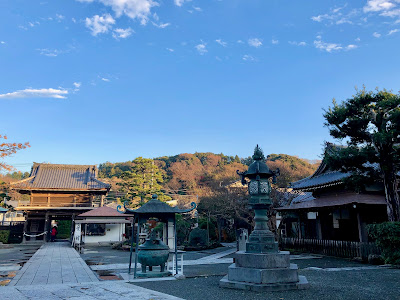目次 / Contents
1) 作品 / Work
2) 帰路 / On My Way Home
3) 妙本寺 / Myōhon-ji Temple
4) 夷堂橋と本覚寺 / Ebisu-dō Bridge and Honkaku-ji Temple
1) 作品 / Work
2) 帰路 / On My Way Home
リトグラフ工房への行き帰りに、できるだけ、違う道を選び、鎌倉の風景の写真を撮影しています。
今年は、コロナのために、予定していた春の時期にリトグラフ工房へ通い始めることができませんでした。
なので、最短距離のルートの行き帰りになりがちです。
今日は、その反省もあり、いつもとは違う帰り道を歩きました。
リトグラフ工房は大町にあるので、帰路は、大町から鎌倉駅へ向かいます。
On My Way Home
On the way back and forth to the lithograph studio, I choose a different path as much as possible and take pictures of the scenery of Kamakura.
This year, because of Corona, I couldn't start going to the lithograph studio at my planned time in the spring.
Therefore, nowadays it tends to be the shortest route going back and forth.
Today, partly because of my reflection, I took a different way home.
The lithograph studio is located in Ōmachi, Kamakura, Kanagawa Prefecture, so on my way back, head from Ōmachi to Kamakura Station.
3) 妙本寺 / Myōhon-ji Temple
 |
| 妙本寺 公式サイト: ★ 時間と体力の余裕があれば境内へも入りたい...。 過去に何度か訪れていますがここ数年 山門をくぐっていませんね〜。 Myōhon-ji Temple Official Website : ★ in English I would like to enter the precincts if I have time and physical strength .... I've visited a few times in the past, but I haven't passed through the gate in the last few years.  妙本寺は、日蓮宗のお寺で、比企谷 (ヒキガヤツ) にあり、 鎌倉時代には比企 能員 (ヒキヨシカズ/ ? - 1203) の 屋敷がありました。 比企 能員 は、十三人の合議制の1人でした。 案内板の下には、2022年NHK大河ドラマ "鎌倉殿の13人" 情報が 加えられています。 Myōhon-ji Temple is a Nichiren sect temple, located in Hikigayatsu Valley, and during the Kamakura period (1185 / 1192 - 1333), there was a mansion of Hiki Yoshikazu (? - 1203). Hiki Yoshikazu was one of the thirteen councilors. Below the information board, information on the 2022 NHK Taiga drama, "The 13 Lords of the Shogun" is added. |
 |
| 比企能員邸阯碑 : ★ Hiki Yoshikazu Residence Monument |
 |
| 古風な家 妙本寺参道沿いに建っています。 Old-fashioned House It is built along the approach to Myōhon-ji Temple. |
 |
| 妙本寺 石塔 参道入口の印のように感じられます。 The Myōhon-ji Temple Stone Monument' is located beside Ebisu-dō Bridge and I feel it is like a signpost to the entrance of the approach. |
4) 夷堂橋と本覚寺
Ebisu-dō Bridge and Honkaku-ji Temple
夷堂橋は、滑川 (ナメリガワ) にかかっており、橋を超えると、
本覚寺 (ホンガクジ) 仁王門前に出ます。
住所表記としては、本覚寺側が小町、妙本寺側が大町になります。
両寺の門は、距離はある程度空いてはいますが、向かい合っています。
夷堂橋は、妙本寺参道のようでもあるし、本覚寺 参道のようでもあります。
2つのお寺は両方とも日蓮宗です。
夷堂橋の名は、昔、本覚寺の門前に夷三郎社があった事に由来します。
夷三郎社は、本覚寺創建時 (1436年) に、本覚寺境内に移され、
'夷堂'となっています。
夷 (エビス) は、恵比寿と同じで、七福神の1つ、エビス様です。
本覚寺の新年の行事、'初えびす'は、有名です。
 |
| Sign of Ebisu-dō Bridge |
Ebisu-dō Bridge and Honkaku-ji Temple
The Bridge spans Nameri River, and when I crossed the bridge,
I reached the front of the Hongakuji Temple's Niō Gate.
According to Wiki about Niō,
"Niō (仁王) are two wrathful and muscular guardians of the Buddha standing today at the entrance of many Buddhist temples in East Asian Buddhism in the form of frightening wrestler-like statues."
As for the area names, Komachi is used on the Hongaku-ji Temple side and Ōmachi is used on the Myohon-ji Temple side.
After crossing the Bridge, I came to be in front of the Hongakuji Temple's Gate.
The gates of both temples are facing each other, although they are some distance apart.
Ebisu-dō Bridge is like the approach to Myōhon-ji Temple and the approach to Hongaku-ji Temple.
Both of the two temples are Nichiren sect.
The name of Ebisu-dō comes from Ebisu Saburo Shrine : Ebisu-dō Hall which used to be in front of Hongaku-j Temple gate.
When the Hongaku-ji Temple was built in 1436, the Shrine : Ebisu-dō Hall was moved to the precincts of Hongaku-ji Temple and became 'Ebisu-dō Hall'.
Ebisu is one of Seven Gods of Fortune (Shichifukujin) , Ebisu God.
The New Year's event of Hongaku-ji Temple, 'Hatsu Ebisu : First Ebisu' is famous.
 |
| 夷堂橋と本覚寺の仁王門 夷堂橋は何度も渡っていますが、 この橋が鎌倉十橋 (カマクラジッキョウ) の1つである と知ってから初めて通ります。 鎌倉十橋は、鎌倉の重要な橋や伝説が残る10の橋で、 観光用として江戸時代に『新編鎌倉志』(1685)で選ばれました。 現在では、橋としては残っていず、碑のみのところもあります。 私が見たいくつかの鎌倉十橋の中で、 この橋が最も大きく利用度も高いように感じます。 Ebisu-dō Bridge and Hongaku-ji Temple's Niō Gate I have crossed Ebisu-dō Bridge many times, This bridge is one of 'Kamakura's Ten Bridges'. I passed for the first time since I knew that. 'Kamakura's Ten Bridges' are 10 bridges of importance or with legends in Kamakura. They were selected for sightseeing in "Shinpen Kamakurashi" (1685 ) during the Edo period. Today, some do not remain as a bridge, and some only noted by a monument. Of a few 'Kamakura's Ten Bridges' I've seen, this one seems to be the largest and most used. |
 |
| 真ん中に見えるのが現在の夷堂です。 You can see the current Ebisu-dō Hall in the middle. |
 |
| 夷堂 / Ebisu-dō Hall |
 |
| 手水舎 今は、コロナ対策で、どこのお寺も神社も手水舎が 使用されていません。 いつから使用されることができるのでしょうか? Chōzuya Nowadays, as a measure against corona, no temples or shrines use Chōzuya. When can they be used? Chozuya are located beside the approaches to shrines and temples, or beside the shrine, where worshipers cleanse their hands and mouth. |
 |
| 獅子舞の頭を持つ神様(?)または子供 (?) が手水鉢を支えています。 ここは何度も通っていますが、初めてそのことに気がつきました。 Gods (?) or Kids (?) with Lion Dance Heads support the Chōzubachi ; basin. I've been to here many times, but for the first time I noticed them.  |
 |
本堂 / Main Hall |
 |
| 境内 本堂から仁王門を撮影しています。 Precincts I am photographing the Nio Gate from the Main Hall. |
 |
鐘楼 / Bell Tower  |
 |
| 日蓮御分骨堂 日蓮御分骨堂は、本堂右脇にあります。 身延山久遠寺 (ミノブサンクオンジ) : ★より移した 日蓮の分骨を祀っています。 久遠寺は日蓮宗の総本山で、 山梨県南巨摩郡身延町(ヤマナシケンミナミコマグンミノブチョウ) にあります。 Nichiren Gobunkotsu-dō Nichiren Gobunkotsu-dō is on the right side of the main hall The hall enshrines some of Nichiren's bones that were moved from Minobusan-kuon-ji Temple. The Kuon-ji Temple is the head temple of the Nichiren sect and is located in Minobu Town, Minamikoma District, Yamanashi Prefecture. |
日蓮御分骨堂の建物は、知っていましたが、名前とそれがなんのためのものなのかを初めて知りました。
I knew of the building Nichiren Gobunkotsu-dō, but for the first time I knew the name and what the hall is for.
 |
| 北門 (裏門?) 若宮大路へ続く路地へ出ます。 North Gate (Back Gate?) Go out to the alley leading to Wakamiya Ōji Street. |
 |
| 境内を振り返る Looking Back on Precincts |
 |
| 北門 / North Gate |
とても久しぶりに境内へ入り、新しい発見もあり、満足して門を出ました。
I entered the precincts for the first time in a long time, and with new discoveries, I was satisfied and left by the gate.











0 件のコメント:
コメントを投稿